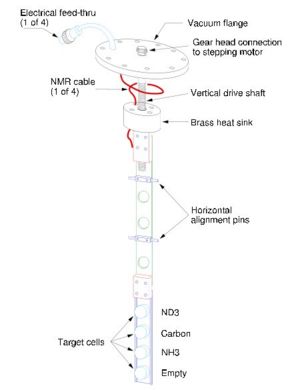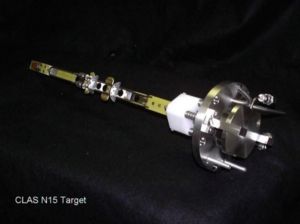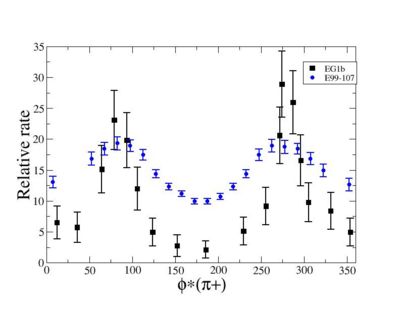Difference between revisions of "PhD Proposal Tamar"
(→Target) |
(→Target) |
||
| Line 22: | Line 22: | ||
The target materials used during the EG1b experiment were frozen ammonia, <math>15NH_3</math> for the polarized protons and <math>15ND_3</math> for the polarized deuterons. Ammonia targets were selected because of their ability to produce high polarization and they are less effected by beam radiation. On the other hand, the damage caused by this radiation can be repair by annealing(heating process). In addition, ammonia target has a high ratio of free nucleons (~3/18) approximately 16.5 % for <math>15NH_3</math> and 26.6 % for <math>15ND_3</math>. One disadvantage of choosing ammonia is the polarization background caused by 15N(spin - 1/2), or 14N(spin - 1). However, for 15N the polarization can be measured easily then for 14N. Also, it does not have any free nucleons, while 14N has one free neutron. That concludes, in case of using 15N ammonia rather than 14N the spin asymmetry measurement should have a smaller correction and error.['''SChen_FSU_thesis'''] | The target materials used during the EG1b experiment were frozen ammonia, <math>15NH_3</math> for the polarized protons and <math>15ND_3</math> for the polarized deuterons. Ammonia targets were selected because of their ability to produce high polarization and they are less effected by beam radiation. On the other hand, the damage caused by this radiation can be repair by annealing(heating process). In addition, ammonia target has a high ratio of free nucleons (~3/18) approximately 16.5 % for <math>15NH_3</math> and 26.6 % for <math>15ND_3</math>. One disadvantage of choosing ammonia is the polarization background caused by 15N(spin - 1/2), or 14N(spin - 1). However, for 15N the polarization can be measured easily then for 14N. Also, it does not have any free nucleons, while 14N has one free neutron. That concludes, in case of using 15N ammonia rather than 14N the spin asymmetry measurement should have a smaller correction and error.['''SChen_FSU_thesis'''] | ||
| + | |||
| + | The EG1 experiment at Jefferson Lab used five different targets during their polarized structure function measurement program. The target materials used during the EG1b experiment were frozen ammonia, <math>15NH_3</math> for the polarized protons and <math>15ND_3</math> for the polarized deuterons, were designed and built by collaboration of the Italian Istituto di Fisica Nucleare, TJNAF, Oxford instruments and the University of Virginia. The solid targets(NH3 and ND3) were polarized using the method of Dynamic Nuclear Polarization [[Prok Thesis]]. Three other targets, C12, liquid He4 and frozen N15 were used to employ several methods for removing the Nitrogen contributions to the measured structure functions made using NH3 and ND3. | ||
| + | Ammonia targets were selected because of their ability to produce high polarization and they are less effected by beam radiation. On the other hand, the damage caused by this radiation can be repair by annealing(heating process). In addition, ammonia target has a high ratio of free nucleons (~3/18) approximately 16.5 % for <math>15NH_3</math> and 26.6 % for <math>15ND_3</math>. One disadvantage of choosing ammonia is the polarization background caused by 15N(spin - 1/2), or 14N(spin - 1), which was eliminated by measuring 15n polarization.['''SChen_FSU_thesis'''] | ||
===The Magnet=== | ===The Magnet=== | ||
Revision as of 19:12, 10 August 2009
Tamar PhD Proposal
Abstract
Introduction
Physics Motivation
Tamuna will have a rough draft of this by Friday July 31,2009.
In semi-inclusive scattering experiment, where the scattered electron and one or more hadrons in coincidence are detected, provides a powerful tool for an understanding the structure of nucleons.
Experimental Setup
Tamuna will finish this section by Friday July 31, 2009
Target
The EG1 experiment at Jefferson Lab used five different targets during their polarized structure function measurement program. The polarized NH3 and ND3 targets were designed and built by collaboration of the Italian Istituto di Fisica Nucleare, TJNAF, Oxford instruments and the University of Virginia. The solid targets(NH3 and ND3) were polarized using the method of Dynamic Nuclear Polarization Prok Thesis. A 5 Tesla magnet establish the hyperfine splittings needed to polarize the target material using X Ghz RF waves. The polarization was monitored by pickup coils around the target using standard NMR techniques. Three other targets, C12, liquid He4 and frozen N15 were used to employ several methods for removing the Nitrogen contributions to the measured structure functions made using NH3 and ND3.
The target materials used during the EG1b experiment were frozen ammonia, for the polarized protons and for the polarized deuterons. Ammonia targets were selected because of their ability to produce high polarization and they are less effected by beam radiation. On the other hand, the damage caused by this radiation can be repair by annealing(heating process). In addition, ammonia target has a high ratio of free nucleons (~3/18) approximately 16.5 % for and 26.6 % for . One disadvantage of choosing ammonia is the polarization background caused by 15N(spin - 1/2), or 14N(spin - 1). However, for 15N the polarization can be measured easily then for 14N. Also, it does not have any free nucleons, while 14N has one free neutron. That concludes, in case of using 15N ammonia rather than 14N the spin asymmetry measurement should have a smaller correction and error.[SChen_FSU_thesis]
The EG1 experiment at Jefferson Lab used five different targets during their polarized structure function measurement program. The target materials used during the EG1b experiment were frozen ammonia, for the polarized protons and for the polarized deuterons, were designed and built by collaboration of the Italian Istituto di Fisica Nucleare, TJNAF, Oxford instruments and the University of Virginia. The solid targets(NH3 and ND3) were polarized using the method of Dynamic Nuclear Polarization Prok Thesis. Three other targets, C12, liquid He4 and frozen N15 were used to employ several methods for removing the Nitrogen contributions to the measured structure functions made using NH3 and ND3.
Ammonia targets were selected because of their ability to produce high polarization and they are less effected by beam radiation. On the other hand, the damage caused by this radiation can be repair by annealing(heating process). In addition, ammonia target has a high ratio of free nucleons (~3/18) approximately 16.5 % for and 26.6 % for . One disadvantage of choosing ammonia is the polarization background caused by 15N(spin - 1/2), or 14N(spin - 1), which was eliminated by measuring 15n polarization.[SChen_FSU_thesis]
The Magnet
The 5 T magnetic field parallel to the beam direction is produced by a superconducting pair of Helmholtz coils, which are cooled by the liquid helium reservoir located outside the CLAS detector. The uniformity of the field is varying less than over a cylindrical volume of 20 mm in diameter and length. This configuration is necessary for DNP. The particles with scattering angles between 0-50 are detected in the CLAS as well as 75-105 due to the 8 cm gap between the Helmholtz coils. The target magnetic field does not interact with the electron beam, however it is effective in shielding the drift chambers from the low energy Moller electrons.The target field bents the scattered particles in the azimuthal direction and it falls rapidly with distance as (). The effect of magnetic field at the drift chambers is negligible.[ref 2]
The Evaporation Refrigerator
The target is cooled to ~ 1 K using the helium, which is supplied from the 1 K evaporation refrigerator. Approximately 0.8 W cooling power is provided by a system of Roots and rotary-vane vacuum pumps that reach a pumping speed for helium gas of 3300 [reference 3].
The Target Inserts
The target insert was designed and built by the INFN of Genova. The target cells with a thickness of 0.2 mm were made out of polychlorotrifluoroethylene (PCTFE), it is a hydrogen-free material and would not produce an NMR background, also it is not effected by radiation as much as other materials. Each target cell is 15 mm in diameter and 10 mm in length sealed by a 0.025 mm thick aluminum foil at entrance window and 0.05 mm thick kapton foil at exit window. LHe in the target cells are supplied from the tiny holes which are located at the exit window and the ammonia beads.[ref 4]
The target insert has the four target cells. Two of them were filled with ammonia beads: the top one with and the other one with . was followed by carbon () disk with a thickness of 2.3 mm and the fourth cell was left empty. The carbon and the empty cells were used to measure background.[ref 4]
The Nuclear Magnetic Resonance(NMR) coils were wrapped around the outside surface of the cells in order to reduce the background, maximize the amount of ammonia in the target cells and monitor the polarization of the target. The geometry of the NMR coils were chosen so that they would be maximally sensitive to the target polarization. They were made out of CuNi material with a thickness of 0.15 mm and bent into rectangular loops. The temperature sensors(thermocouples, RuO resistors) were attached to the target insert at different locations to monitor the temperature of the target materials.[ref 4]
A second target insert was designed and built by the Jefferson Lab Polarized Target Group to measure the background using solid . The first measurements of electron scattering from target provided the data which was subtracted from the scattering data in order to eliminate the contribution of the . The insert cell is made out of a Torlon of 15.7 mm in diameter and 12.7 mm in length. Both sides of the cell are covered by kapton windows. The target cell was filled with isotopically enriched gas at room temperature and the insert was located into the target chamber in order to cool it by LHe, causing the gas to condense. To avert the target from freezing a heater wire was wrapped around the filling tubes and plugging the tubes before the cell was filled with the gas.
The target insert during the experiment is moved up or down using the stepping motor, which means that the target can be changed automatically.[ref 4]


